- Quick Read
- Deep Read ( 6 Min. )

Why is Christian Science in our name?
Our name is about honesty. The Monitor is owned by The Christian Science Church, and we’ve always been transparent about that.
The Church publishes the Monitor because it sees good journalism as vital to progress in the world. Since 1908, we’ve aimed “to injure no man, but to bless all mankind,” as our founder, Mary Baker Eddy, put it.
Here, you’ll find award-winning journalism not driven by commercial influences – a news organization that takes seriously its mission to uplift the world by seeking solutions and finding reasons for credible hope.
Explore values journalism About usIn Today’s Issue
- Where the wildflowers grow ... in a Ukrainian war zone
- Today’s news briefs
- Why Israeli relief over hostages’ rescue from Gaza was short-lived
- Hunter Biden trial puts first family’s travails in election-year spotlight
- The end of globalization? US protectionism points to a shift.
- In South Africa, curbing violence starts with showing boys their potential
Monitor Daily Podcast
- Follow us:
- Apple Podcasts
- Spotify
- RSS Feed
- Download
TODAY’S INTRO
Resilience in the wake of war
After the costs of war on human life come the effects on everything people have built and grown. In Gaza, a ravaged infrastructure will need replacing. In Ukraine, despoiled croplands will require painstaking regeneration.
Howard LaFranchi, who wrote about the Ukrainian military’s agency in getting grain flowing again to global markets, reports today on the resilience of nature and villagers a year after the destruction of a Soviet-era dam.
Predictions were apocalyptic. Industrial sludge had flowed. The toxic aftermath can’t be ignored, but residents who stayed now nurture new growth. They rejoice that a toxic bloom didn’t materialize.
Some villages are dying, one man told Howard. “But we will do what we can to keep ours alive.”
Share this article
Link copied.

Help fund Monitor journalism for $11/ month
Already a subscriber? Login

Monitor journalism changes lives because we open that too-small box that most people think they live in. We believe news can and should expand a sense of identity and possibility beyond narrow conventional expectations.
Our work isn't possible without your support.
Where the wildflowers grow ... in a Ukrainian war zone
Here’s Howard’s report, which is really about rejecting the inevitability of ecological catastrophe – “ecocide,” as some had termed it – while not underplaying the havoc that a dam’s destruction did cause.

When the Kakhovka Dam in southern Ukraine blew up a year ago, allegedly destroyed by Russian troops, scientists predicted that the flash evacuation of its massive reservoir would be an environmental calamity of global proportions.
In particular, they warned that the 832 square miles of land once submerged beneath the reservoir would become a toxic desert. But actually, willows and aspen trees are sprouting vigorously there today, and frogs are jumping all over the place, points out Vadym Maniuk, a professor of ecology, as he shows a visitor around.
At the same time, residents of the cities and villages downriver are still struggling to recover – especially amid a war.
Dr. Maniuk is aware that his enthusiasm might come off as indifference to the human suffering that the dam’s collapse unleashed. Entire neighborhoods in the downriver city of Kherson were flooded, dozens of villages were inundated, miles of irrigation channels were destroyed, and sensitive ecosystems were washed away to the Black Sea.
“Of course it was a catastrophe; the social impact was huge for the people who lived along the river and the farmers who lost their irrigation systems,” he says. “But we’re also seeing some good results that were not anticipated in all the dire predictions.”
Where the wildflowers grow ... in a Ukrainian war zone

When the Kakhovka Dam on Ukraine’s Dnieper River was destroyed a year ago, apparently by Russian troops, the flash evacuation of its massive reservoir was deemed an environmental calamity of global proportions.
In particular, scientists predicted that the 832 square miles of land once submerged beneath the reservoir would become a toxic desert of dried industrial sludge, agricultural runoff, and sewage.
But as Vadym Maniuk presses deep into the thick young forest of river willows and aspens now carpeting the reservoir floor, the professor of ecological studies at Dnipro National University highlights the evidence that he says debunks the apocalyptic predictions – and attests to what he calls nature’s indomitable regenerative power.
“Look at this willow; it sprouted and grew to this size in just one year,” he says with wonderment of a tree that reaches almost twice his height. “Look down,” he adds. “This place they declared dead is alive in so many ways,” as he points to the hundreds of tiny frogs that scatter with every step he takes.
“This is what they called the ‘Great Meadow’ before the dam was built, [what] my grandmother used to tell me was her childhood playground,” Dr. Maniuk recalls as he surveys the expanse of green from a nearby hill. “Now it seems we could be getting the Great Meadow back.”
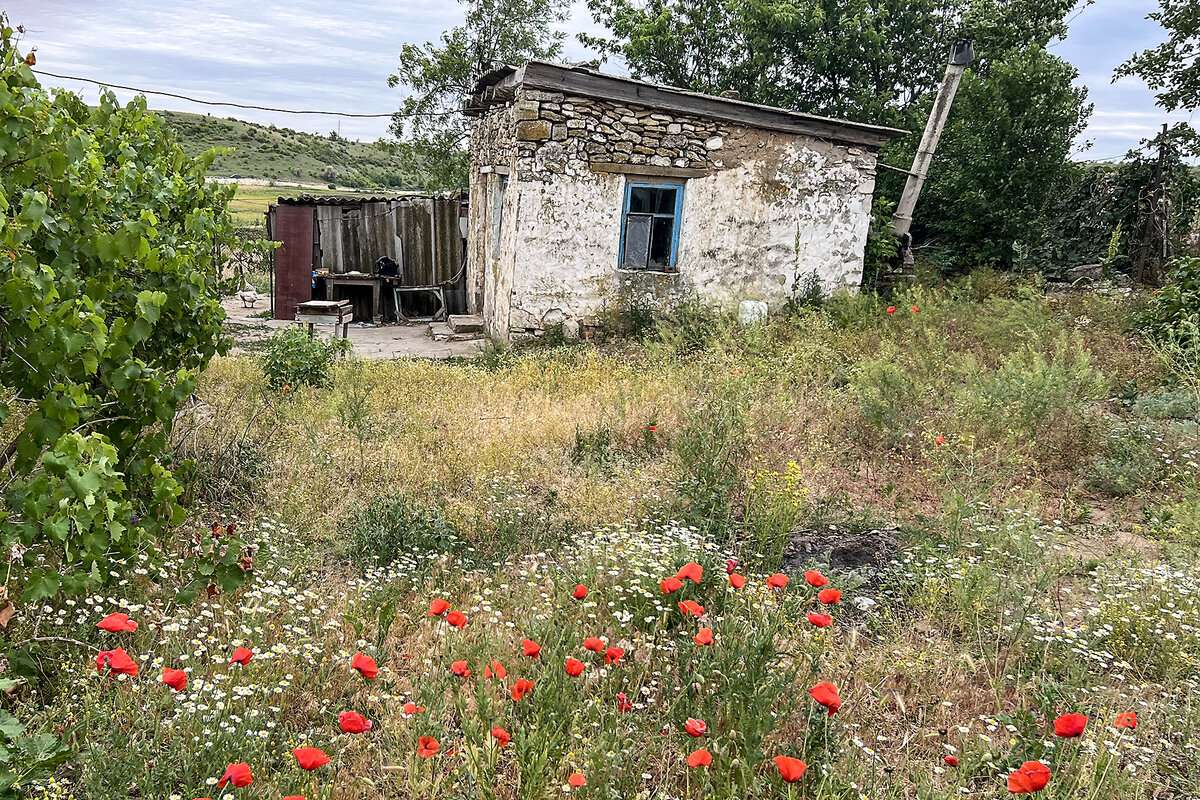
Russian forces in control of the Kakhovka site are believed to have set off the explosion that caused the dam’s demise, as part of a continuing campaign to knock out electricity generation plants, destroy Ukraine’s economy, and thin out the population. Environmentalists and economists are now debating the disaster’s lasting ecological impact.
At the same time, residents of the cities and villages downriver are still struggling to recover – especially amid a war.
Some good results
Dr. Maniuk is aware that his enthusiasm might come off as indifference to the human suffering that the dam’s collapse unleashed. Entire neighborhoods of the downriver city of Kherson were flooded, dozens of villages were inundated, miles of irrigation channels were destroyed, and sensitive ecosystems were washed away to the Black Sea.
“Of course it was a catastrophe; the social impact was huge for the people who lived along the river and the farmers who lost their irrigation systems,” he says. “But we’re also seeing some good results that were not anticipated in all the dire predictions.”
Some of the centuries-old villages along the river and its tributaries were unable to withstand the double punch of the war and the flooding. They now sit vacant – smashed and silent.
In others, new windows, fresh paint, and neat vegetable gardens attest to life.
But nowhere is that life the way it was before the war and the floods, remaining residents say.
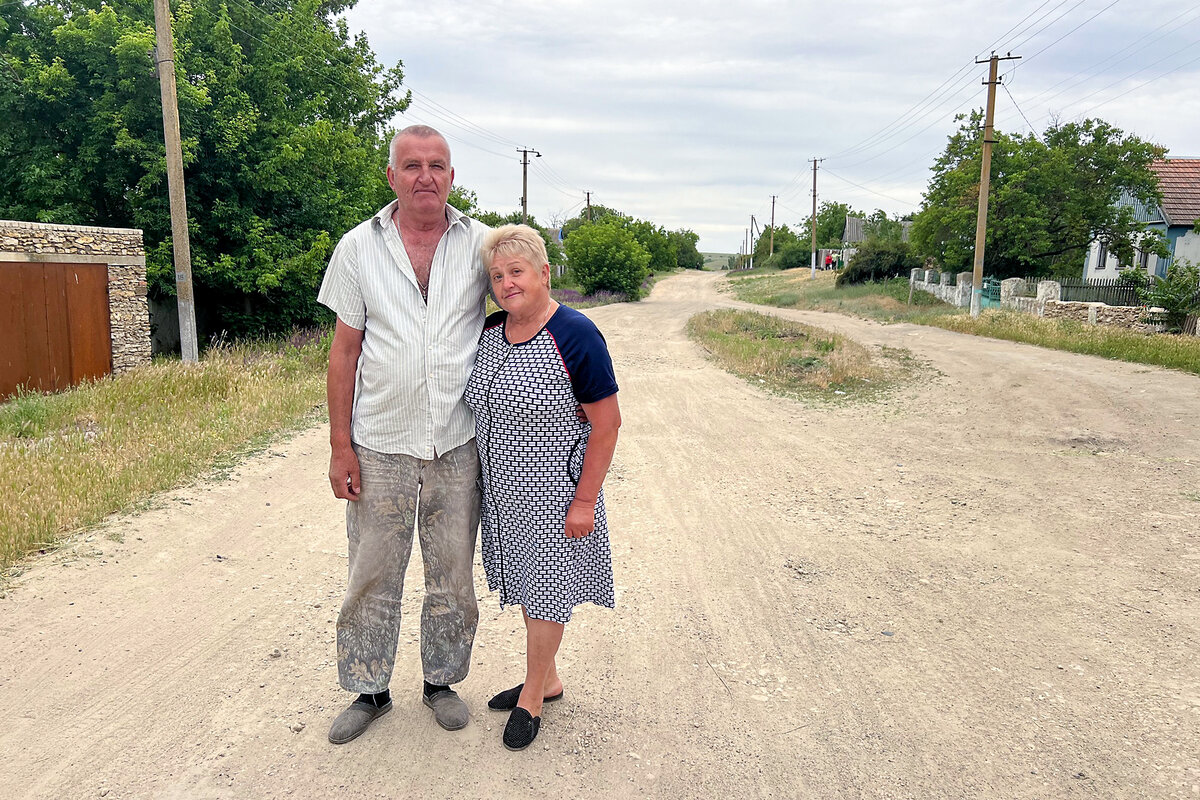
“Only two houses on our street are occupied; the other families have left,” says Mykola Dudnichenko, as he gestures up and down the dirt road outside his house in Krasnoliubetsk, a village on the banks of a Dnieper tributary.
They left behind unexploded mines that floated into farmers’ fields and lodged there, the absence of potable water, worries about potentially toxic residues, and the lack of jobs, he adds. “You understand why so many have left.”
Mr. Dudnichenko’s wife, Valentyna, says people often ask how they can stay put, living so close to a war. The former music teacher at a nearby orphanage says she tells them the flood was much worse.
“When the shells come, you can seek proper shelter, but there is no escaping floodwaters,” she says, recalling how the nearby river reversed course and flooded from downstream as the engorged Dnieper blocked its tributaries’ normal flow.
“The water is really much scarier; there is nothing you can do,” she adds, choking up at the memory of it.
She weeps as she recalls the drowned chickens, the cows and other farm animals people let loose to fend for themselves – and the field mice that came running in droves, seeking shelter in her house.
“But then the water rose above the windows,” she says, wiping away tears. “So the house offered no protection.”
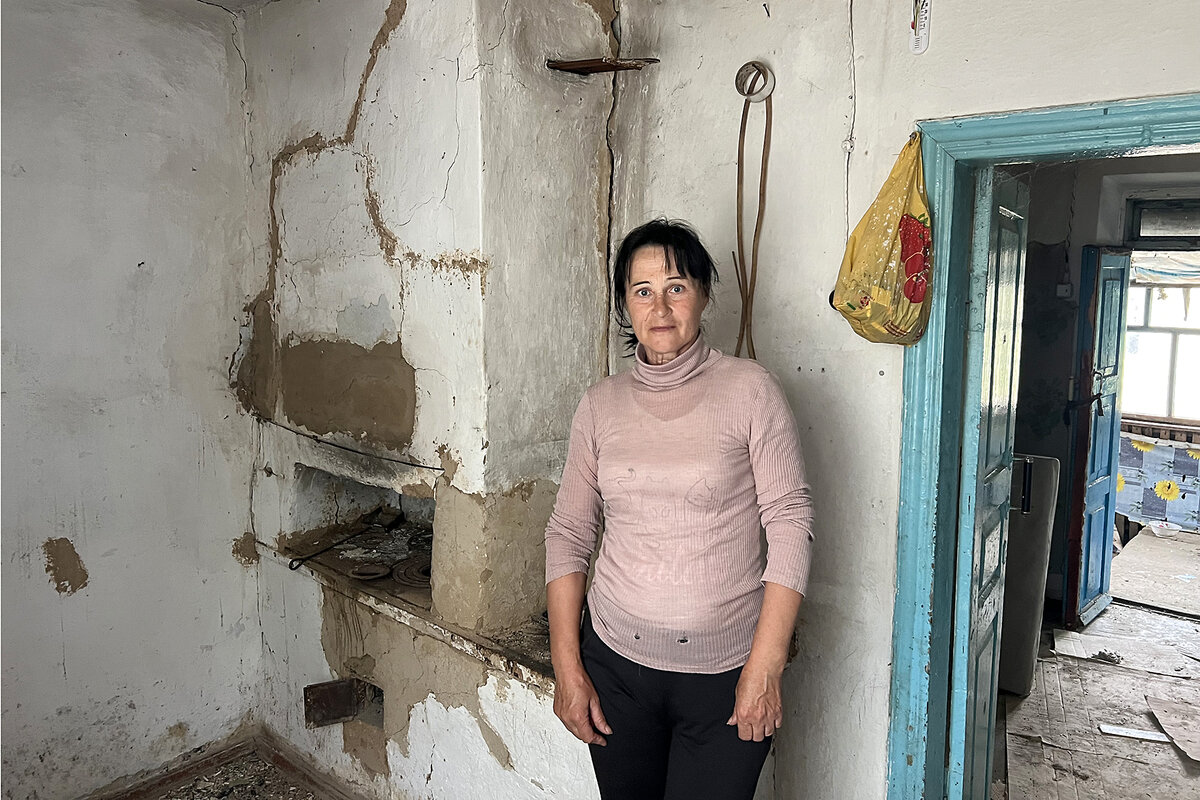
Moscow accused of ecocide
Across the Inhulets River, in the village of Zapovit, Svitlana Zyma opens the door to her house, which floodwaters left uninhabitable.
“Everything was taken over by a toxic mold,” she explains. “Then the walls crumbled, so we knew it would be a long time before anyone could live here.”
Ms. Zyma, who has moved into another house nearby, says she has watched her once vibrant community decline “in waves,” first as a result of the war, and more recently since the flood.
“I could move to Mykolaiv,” she says, referring to a nearby city, “but how would I ever pay the rent?”
As Ms. Zyma resigns herself to live with the environmental consequences of the Kakhovka Dam’s destruction, the Ukrainian authorities have seized on them as evidence of a novel crime under international law – “ecocide.”
Last February, Ukraine became the first country to formally lodge allegations of ecocide at the International Criminal Court at The Hague. Kyiv is now pursuing more than a dozen such cases, several of which stem from the Kakhovka Dam’s destruction.
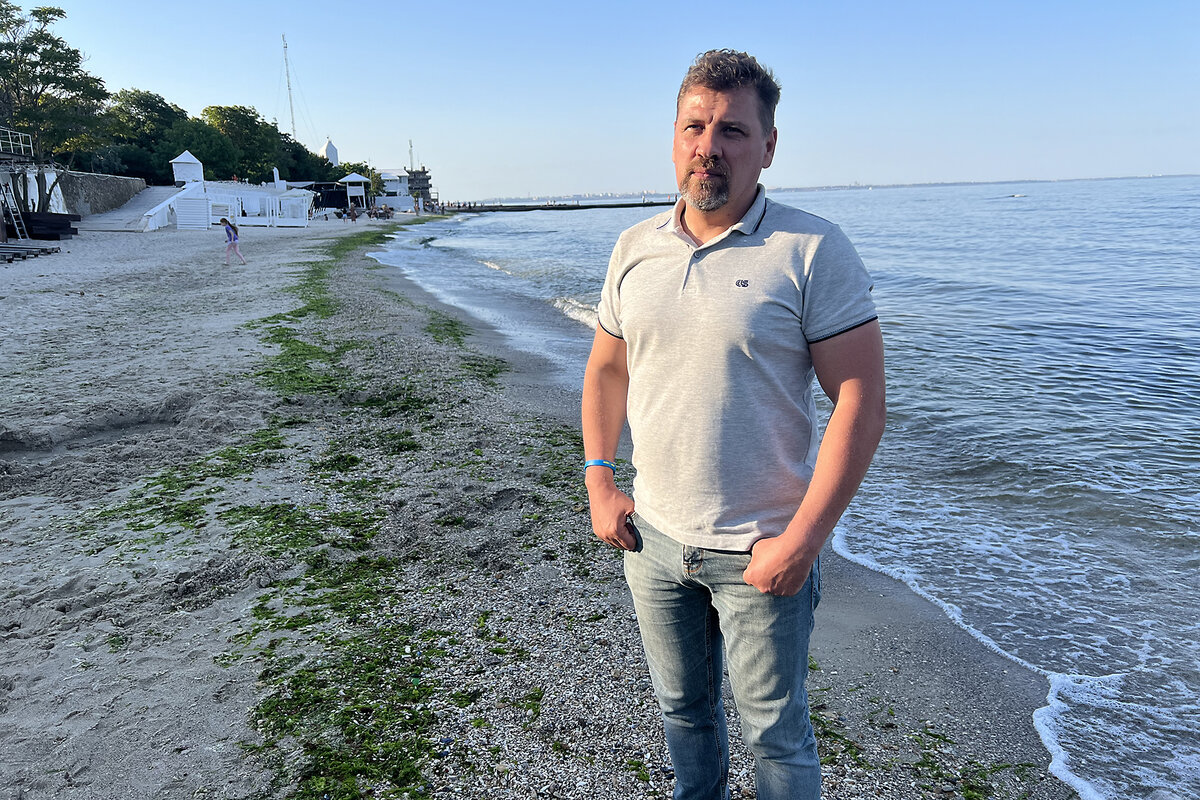
Odesa environmentalist Vladislav Balinskyy says he has no doubt that the dam’s destruction resulted in ecocide. Whole ecosystems of the Dnieper River’s estuaries were destroyed, and dozens of species of fish, lizards, small amphibians, dolphins, and rare plants were lost, he says.
But he acknowledges some brighter environmental results amid the overall catastrophe.
“We have lost some unique biodiversity we will never restore, and the grave problem of toxic silt is going to be with us for a long time,” says Mr. Balinskyy, head of the Green Leaf environmental organization. But it’s true, he adds, that “some of the direst predictions did not come true.”
A storm over the Black Sea mixed cooler sea waters with warmer river runoff, he points out, nipping in the bud the toxic bloom many experts had predicted. And the dam broke just as river willows and other trees were releasing trillions of seeds, thus seeding the reservoir’s bed and restoring the Great Meadow.

NASA, Institute for the Study of War
With a similar mix of trepidation and hope, the Dudnichenkos planted a vegetable garden this spring, even though they worry that toxic floodwaters may have poisoned their soil.
They rail against the lack of government assistance to help them recover from the flood, but they also plan to stay put. They bicycle up the hill every day to fetch safe water from a plastic tank that regional authorities installed. They care for their chickens, ducks, and pigs, and for Refugee, the cat that showed up on their doorstep after the flood.
“The villages here are dying; it’s true,” Mr. Dudnichenko says. “But we will do what we can to keep ours alive.”

NASA, Institute for the Study of War

Today’s news briefs
• Power shift in Europe: Far-right parties rattle the traditional powers in the European Union with major gains in parliamentary seats, dealing an especially humiliating defeat to French President Emmanuel Macron, who called snap legislative elections.
• Key resignation in Israel: Benny Gantz, a centrist member of Israel’s three-person war Cabinet, announces his resignation, accusing Prime Minister Benjamin Netanyahu of mismanaging the war effort and putting his own “political survival” over the country’s security needs.
• Hajj to begin this week: Muslims coming to Saudi Arabia will unite in a series of rituals and acts of worship as they perform Hajj, one of the Five Pillars of Islam. The pilgrimage is required once in a lifetime of every Muslim who can afford it and is physically able to make it.
• Justices disclose gifts: U.S. Supreme Court justices reported receiving gifts including a stay in a Bali, Indonesia, hotel and tickets to a Beyoncé concert, as well as nearly $1.6 million in book advances and royalties, in annual financial disclosure forms for 2023 released June 7.

Why Israeli relief over hostages’ rescue from Gaza was short-lived
The emotion that swept Israel Saturday after the electrifying news that four hostages had been brought home to safety from Gaza was pure joy. But within hours, the unresolved questions raised by the war against Hamas had reasserted themselves.

- Quick Read
- Deep Read ( 7 Min. )
-
By Shoshanna Solomon Contributor
Israelis breathed a huge sigh of relief at the news Saturday that commandos had liberated four living hostages. A veteran TV journalist burst into tears in a live broadcast, and people with flags poured dancing into the streets.
But it quickly became clear that none of Israel’s remaining challenges from the war in Gaza – military, diplomatic, or political – had been materially altered. By nightfall, a grim reality once again cloaked the nation: concern for the remaining 120 hostages and the nation’s increasing global isolation, made worse as the reported Palestinian death toll from the rescue operation surged past 200 people.
Prime Minister Benjamin Netanyahu came under immediate fire for politicizing the hostages’ release. On Sunday night, former military chief Benny Gantz pulled his centrist party from the government over its failure to adopt a day-after plan for Gaza.
The rescue was “a very good and emotional intermezzo” in the saga of Israel’s woes, says protester Miri Pinchuk at an antigovernment demonstration in Tel Aviv Saturday night. But it will not have any “long-term impact” on Israel’s future. “We need an overall political solution that will build a new reality here instead of hate and war.”
Why Israeli relief over hostages’ rescue from Gaza was short-lived
Israelis erupted in a spontaneous outpouring of joy Saturday as news broke over the dramatic rescue of four hostages held by Hamas. But the euphoria was short-lived, as it quickly became clear that none of Israel’s remaining challenges from the war in Gaza – military, diplomatic, or political – had been materially altered.
Prime Minister Benjamin Netanyahu came under immediate fire from hostages’ advocates and others for politicizing the release. Former military chief Benny Gantz pulled his centrist party from the government over its failure to adopt a day-after plan for Gaza. And Monday it was reported the Biden administration was trying to negotiate a side deal with Hamas to secure the release of American citizens still held hostage.
Israelis were whipsawed from grief to joy and then back to grim reality in mere hours.
Just days before the rescue, Israelis had learned that four other hostages, who had been seen alive in Hamas propaganda videos, had died in captivity.
On Saturday, the nation breathed a huge sigh of relief at the news that commandos had liberated four living hostages. A veteran TV journalist burst into tears in a live broadcast, lifeguards announced the news by megaphone to cheering beachgoers, and people grabbed flags to pour dancing into the streets.
But by nightfall Saturday, a grim reality once again cloaked the nation: Israelis fretted over the remaining 120 hostages and over widening social and political cracks, the high human and economic toll of Israel’s longest war, and the nation’s increasing global isolation, made worse as the reported Palestinian death toll from the rescue operation surged past 200 people.
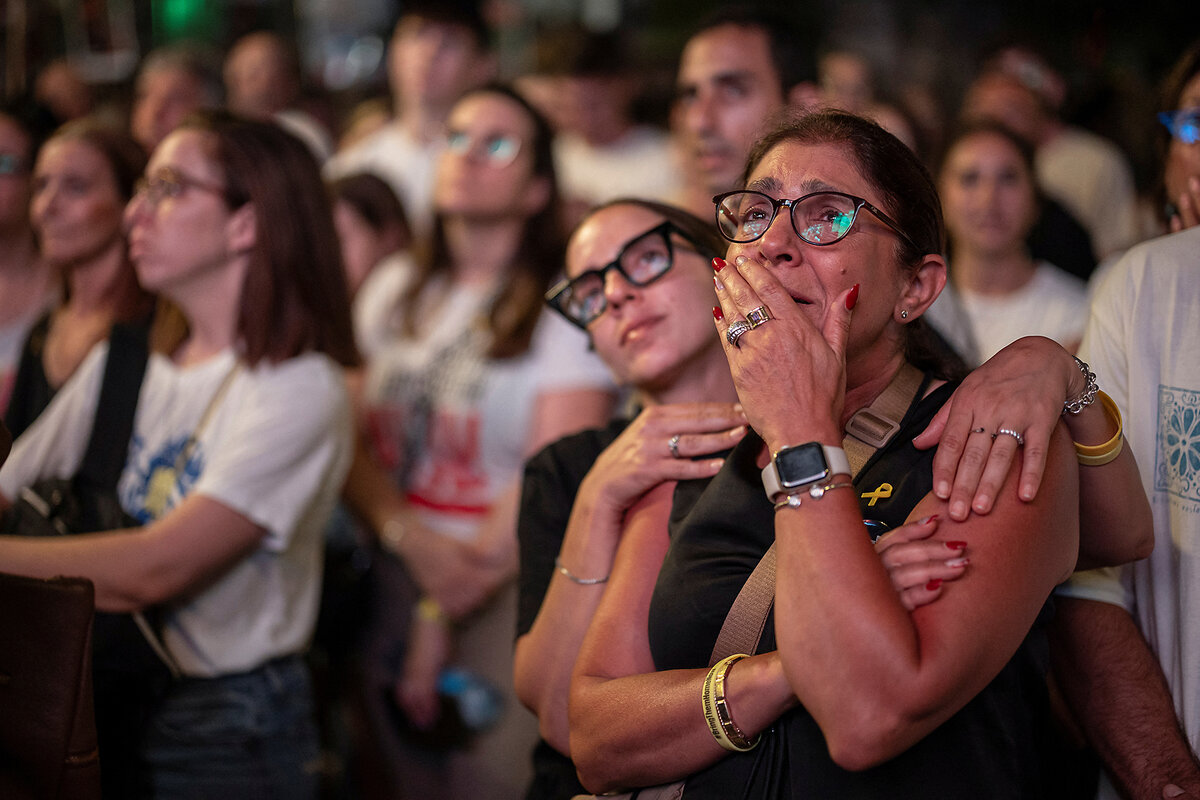
The successful rescue of four living hostages was a “sweet drop of water in a sea that is salty,” says Eyal, an Israeli demonstrator giving only his first name and sitting on the pavement at an antigovernment protest in Tel Aviv Saturday night.
There are “security, economic, social, and international relations” issues that need to be urgently addressed to get the nation back on its feet, he says gloomily. “We need a lot of work and a lot of hope.”
Pressure on Netanyahu
Mr. Netanyahu has come under intensified criticism at home and abroad for his conduct of the war. And Mr. Gantz, in his resignation announcement, and U.S. President Joe Biden, in an interview last week, both gave support to the contention that the prime minister has prolonged the war for political gain. After eight months, the war aims of rescuing the hostages and breaking down Hamas’ military and governing abilities still seem distant.
On Monday, NBC News reported that Biden administration officials have discussed negotiating a deal with Hamas to release five American hostages held since Oct. 7 if current efforts to secure an Israeli-Hamas cease-fire fail. Secretary of State Antony Blinken arrived in the region Monday to promote a cease-fire deal previously outlined by President Biden that holds the promise of a longer and broader settlement. At the United Nations, the Security Council passed a resolution Monday afternoon endorsing the U.S.-backed cease-fire plan.
If the NBC report is accurate, “it would be dramatic news,” says Professor Gideon Rahat, chair of the political science department at the Hebrew University in Jerusalem. “Israel sees itself as the safe haven for Jews globally. But now it is President Biden, and not the Israeli government, that is saving the Jews.”
“It is clear that this is a leak that is meant to pressure Mr. Netanyahu to agree to a cease-fire deal,” Professor Rahat says.
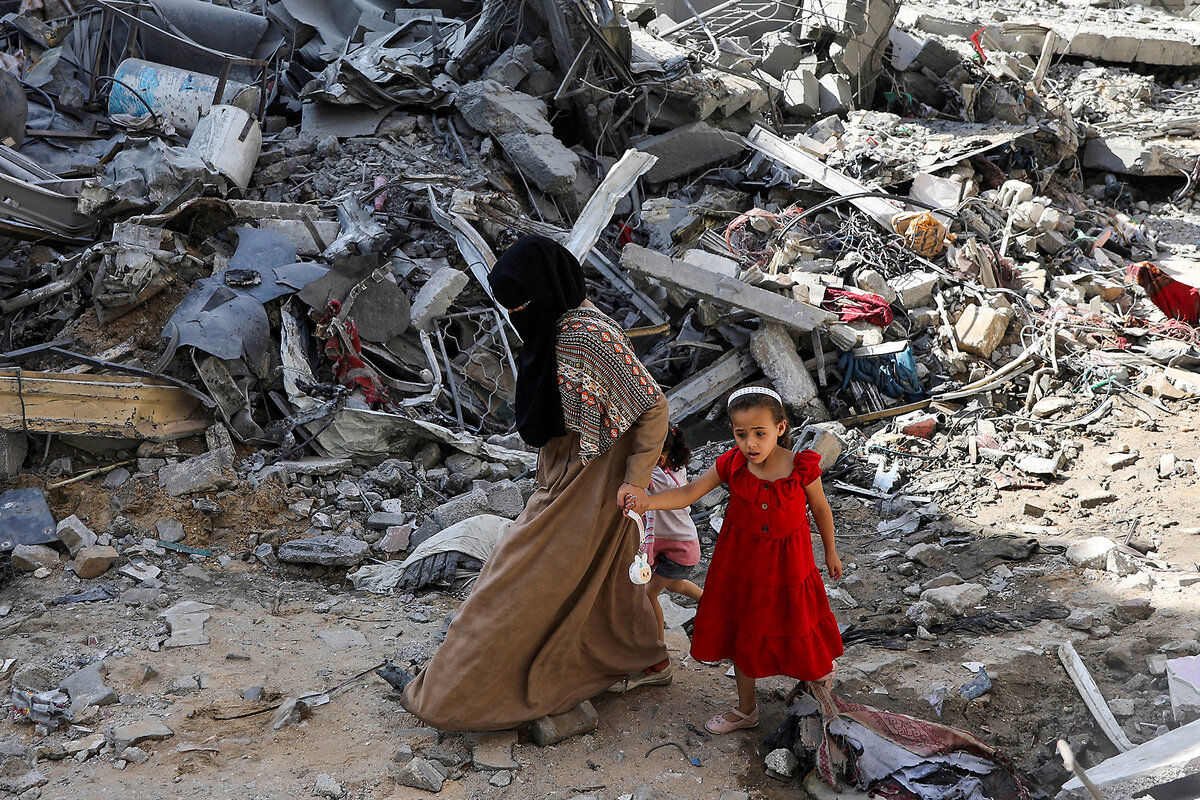
In his resignation announcement Sunday night, Mr. Gantz accused Mr. Netanyahu of preventing Israel from “advancing to real victory” and called for early elections.
The departure of Mr. Gantz’s National Unity Party from the emergency government is not expected to pose an immediate risk to the right-wing coalition, which still has 64 seats in the 120-seat Knesset, says Professor Rahat.
“What it will do is increase even further Israel’s international isolation, as Mr. Gantz and his party were seen as the responsible adults, the voice of reason, within the government,” he says. But Mr. Netanyahu “likes this global isolation,” he says. “He likes to show Israelis how strong he is vis-à-vis a hostile world. It works for him.”
Professor Rahat says it is likely that Mr. Netanyahu will try to add opposition members to his government. “This will allow him to juggle opposing views within his government and in this way buy time, which is what he wants. He tries to buy time.”
Yohanan Plesner, president of the Israel Democracy Institute, said in a statement that the departure of Mr. Gantz’s party from the coalition “is incredibly consequential to Israeli politics.” The participation of Mr. Gantz and his team at critical junctures of war decisions gave a “broad swath [of] Israelis a higher level of confidence that critical wartime decisions were being made with moderate voices in the room and broad national representation, rather than narrow political interests.”
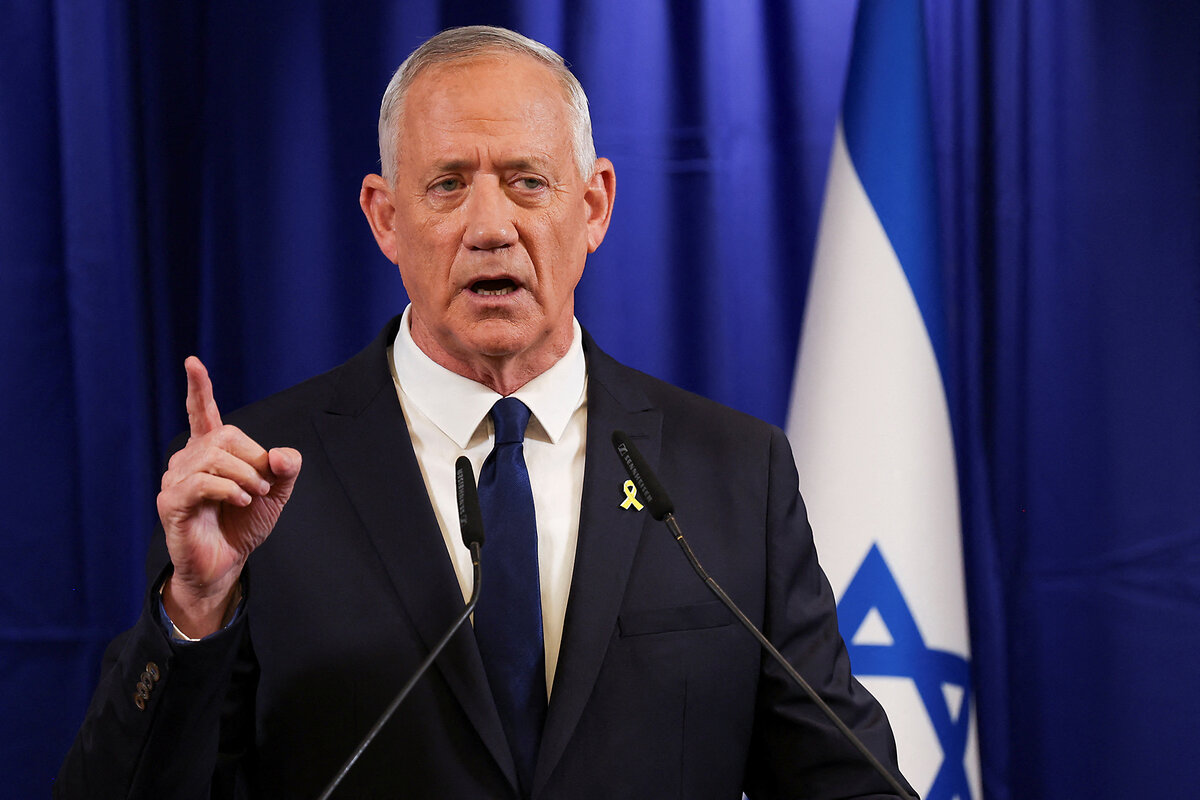
Photo ops
Meanwhile, Mr. Netanyahu came under much public criticism for rushing Saturday to meet the just-freed hostages and publishing those images for political gain, while he has not yet met the bereaved family members of hostages who have died.
Avi Marciano, the father of hostage Noa Marciano, whose body was retrieved by soldiers, said in a Facebook post that he is “happy with all his heart for all the families who got to embrace their loved ones. I’m also jealous. This highlights how our ending was bad. When it ends badly, the prime minister doesn’t come. He also doesn’t call.”
Among the hostages freed Saturday was Noa Argamani, who was seen Oct. 7 being rushed away from the site of an outdoor concert on a motorcycle sandwiched between militants as she cried out, arms outstretched, for help. Israeli commandos rescued her and the others from civilian homes in the midst of the Nuseirat refugee camp in central Gaza.
The rescue mission has underlined the complexity of freeing prisoners held either underground or among civilians, highlighting for many the urgent necessity of a deal to get back the remaining 120 hostages, many of whom are deemed to be already dead. Since Oct. 7, 2023, when more than 250 people were taken hostage by Hamas, just seven have been rescued alive. More than 100 others were released under a temporary cease-fire deal, which eventually broke down. Three others were mistakenly killed in December by Israeli troops.
Israel Defense Forces spokesperson Daniel Hagari said Saturday that the “heroic” and “high-risk” mission was based on precise intelligence for which commando teams prepared for weeks.
The commander of one rescue squad was fatally wounded in the operation by heavy Hamas fire. The Hamas-run health ministry in Gaza said the raid killed more than 270 people, including children and other civilians, from heavy artillery barrages and airstrikes.

The rescue sends a “very strong signal” to Israel’s enemies about its military capabilities, says Avi Kalo, a lieutenant colonel in the reserves and a former head of the military intelligence department dealing with soldiers missing in action. But “it does not significantly improve” Israel’s strategic situation regarding the war, and certainly not with regard to the hostages held by Hamas, he said Sunday at a briefing with journalists.
Rescue options limited
An operation such as the one executed Saturday “cannot be the platform to return all the hostages, whose time in the tunnels is running out,” Mr. Kalo said. Hamas is now likely “tightening its guard” over the remaining hostages and will draw lessons from the “loopholes” that led to their rescue, he said.
A Hamas spokesperson said in a statement Saturday that the Israeli operation will pose a “great danger” to remaining hostages and negatively impact their conditions and lives.
Rear Admiral Hagari, the Israeli military spokesperson, voiced doubt that more such operations would follow, given their complexity and requirements.
“We know that we can’t do operations in order to rescue all of them because there aren’t always the conditions that allow that,” he said at a briefing Saturday. “We saw in the past that what brought us the biggest number of hostages was a deal.”
At the Tel Aviv demonstration Saturday night, protester Miri Pinchuk concurred. The rescue was “a very good and emotional intermezzo” in the saga of Israel’s woes, she says, but it will not have any “long-term impact” on Israel’s future. “We need an overall political solution that will build a new reality here instead of hate and war.”

Hunter Biden trial puts first family’s travails in election-year spotlight
For President Joe Biden, whose life has been marked by tragedy, son Hunter’s gun trial adds family drama – and a supercharged legal dimension – to an already unusual presidential election.

- Quick Read
- Deep Read ( 4 Min. )
The criminal trial of Hunter Biden, the president’s only surviving son, has shined a light on the human, legal, and political dramas swirling within and beyond the first family.
The younger Mr. Biden faces three federal felony counts in Wilmington, Delaware, related to his 2018 purchase of a firearm during a period when he struggled with drug addiction. His defense centers on whether he knowingly lied on the gun purchase form, on which he said he was not using illegal drugs. If convicted, he could be sentenced to prison.
Mr. Biden also faces a federal trial in California on charges of tax evasion. The two cases stem from the implosion of a plea deal last summer.
The Hunter Biden case pales in significance to the legal woes of former President Donald Trump, who was found guilty last month of falsifying business records and has been indicted in three other criminal cases.
But for President Joe Biden, who has faced multiple family tragedies during his career, son Hunter’s saga represents an unprecedented dimension in the heat of a presidential election campaign already unlike any other.
Hunter Biden trial puts first family’s travails in election-year spotlight

The criminal trial of Hunter Biden, the president’s only surviving son, has shined a light on the human, legal, and political dramas swirling within and beyond the first family.
Reduced to essentials, the case is not complicated: The younger Mr. Biden faces three federal felony counts in Wilmington, Delaware, related to his 2018 purchase of a firearm during a period when he struggled with drug addiction. His defense centers on whether he knowingly lied on the gun-purchase form, where he said he was not using illegal drugs, a required condition for buying firearms. If convicted, he could be sentenced to prison.
Mr. Biden has also been indicted on federal charges of tax evasion, a case scheduled for trial in California in September. The two cases stem from the implosion of a plea deal last summer that would have immunized the first son from future potential charges.
The Hunter Biden case pales in significance to the legal woes of former President Donald Trump, who was found guilty last month of falsifying business records in a hush-money deal with a porn star. Mr. Trump, the GOP’s presumptive presidential nominee in November, has also been indicted in three other criminal cases.
Hunter Biden, of course, isn’t running for office – let alone reelection as president, as his father is. And certainly the specter of a presidential relative facing personal and legal problems is nothing new. Throughout history, many presidents have had family members who have attracted embarrassing (or worse) public attention.
But for President Joe Biden, whose life has been marked by tragedy, his son’s saga represents an unprecedented dimension in the heat of a presidential election campaign already unlike any other.
As a political matter, the Hunter Biden gun case is unlikely to have an impact, analysts say. Even if voters across the political spectrum themselves have experience with relatives struggling with addiction, “I suspect reactions will be heavily dependent on party ID,” says Michael Traugott, a presidential scholar emeritus at the University of Michigan, Ann Arbor.
“Republicans, especially, are not likely to be swayed by this in any positive way or accept a very sympathetic view,” Professor Traugott says.
President Biden has sought to avoid an appearance of conflict of interest. When asked last week in an ABC News interview if he would accept the outcome of his son’s trial, he said “yes.” The president also ruled out a pardon in the event of a conviction.
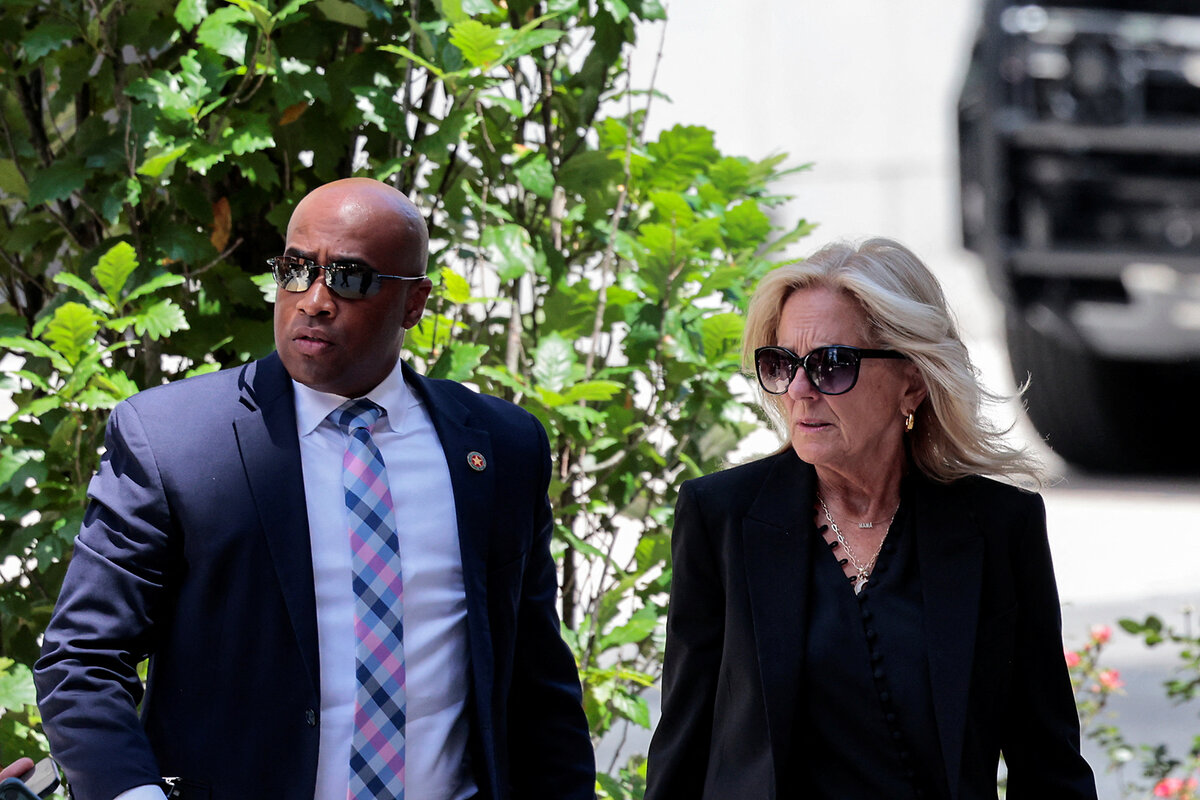
At the same time, Mr. Biden accused Mr. Trump of trying to undermine the rule of law in the former president’s claim that his conviction last month in a New York state case was politically motivated. Two of Mr. Trump’s remaining cases are federal, sparking accusations by the former president and his allies that the Biden administration has weaponized the Justice Department against him.
That the Hunter Biden case is also federal cuts a bit into that argument, as have federal indictments of two Democratic lawmakers – Sen. Robert Menendez of New Jersey and Rep. Henry Cuellar of Texas.
Biden critics counter that the earlier Hunter Biden plea deal was a “sweetheart” arrangement by his father’s Justice Department that collapsed at the last minute only because the judge blew the whistle.
House Republicans also intend to keep pursuing their investigation into Hunter Biden’s business dealings, which they say also implicates the president. Last week, the Republican chairs of three House committees urged the Justice Department to charge Hunter Biden and the president’s brother James Biden with making false statements to Congress. The allegations come within an ongoing impeachment inquiry into President Biden.
“Now, we’re going to do everything we can to hold Hunter Biden and all the different shady associates accountable. This is just the beginning,” House Oversight Committee chair James Comer said Sunday on Fox Business. “But the next step will be accountability for Joe Biden.”
The impeachment inquiry into President Biden has so far failed to surface firm evidence of wrongdoing, despite claims that he had abused his office for financial gain. But if Mr. Trump wins in November, he has suggested he will seek legal retribution against his political enemies, including Mr. Biden.
For the president, the trial of his son represents nothing less than the latest chapter in a life marked by tragedy. Early in his political career, President Biden lost his first wife – Hunter’s mother – in a car crash, along with the Bidens’ baby daughter when Hunter and his brother, Beau, were young boys. Beau Biden, seen as the family’s rising political star, died of cancer in 2015.
After that loss, Hunter Biden went into a spiral of drug abuse and infidelity, destroying his marriage. After Beau’s death, Hunter and Beau’s widow, Hallie Biden, became romantically involved, ensnaring her as well in drug use for a time. Both Hallie Biden and Hunter Biden’s ex-wife, Kathleen Buhle, testified at the trial for the prosecution, in an extraordinary airing of family dysfunction unprecedented in modern American presidential politics.
Hunter Biden’s oldest daughter, Naomi Biden Neal, testified Friday for the defense, saying that her father had gained control of his drug abuse at the time he purchased a gun – an effort to show that Mr. Biden hadn’t lied on his firearms application. But on cross-examination, the prosecution seemed to undermine Ms. Biden Neal’s testimony by presenting contemporaneous text messages between her and her father portraying anguish over his behavior.
Biden family members have shown up daily to support Hunter – including first lady Jill Biden, who shuttled back and forth between France (where her husband was traveling) and Wilmington. A remaining question, as the trial was expected to head soon to the jury, was whether Hunter Biden himself would testify. Monday morning, the defense announced he would not.
The jury deliberated for one hour Monday and is scheduled to resume Tuesday morning at 9:00 a.m.

The Explainer
The end of globalization? US protectionism points to a shift.
Developed countries are increasingly adopting protectionist policies to give themselves an economic advantage over competitors. Does that sound globalization’s death knell?
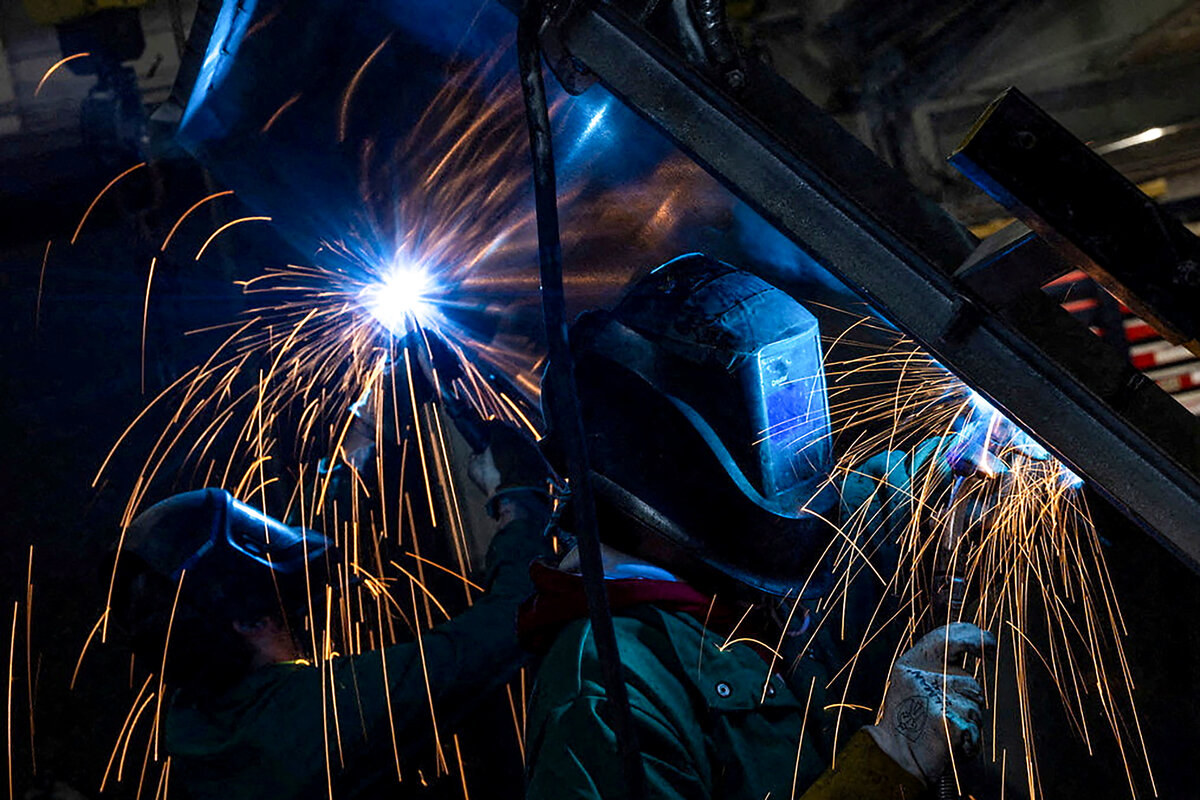
- Quick Read
- Deep Read ( 4 Min. )
When President Joe Biden slapped a 100% tariff on Chinese electric vehicle imports last month, it was clearly a protectionist move. But does it mean that globalization – the free trade force that has made the modern world – is in retreat?
There is certainly a shift in the developed world toward what is known as “industrial policy.” That’s an umbrella term for policies that deliberately favor certain sectors of the economy, for example using subsidies and trade protections.
Once, the goal was to boost growth. Now, it is more a matter of encouraging the green economy and of securing supply chains, making them less dependent on distant, and sometimes unreliable, trade partners.
From the U.S. Inflation Reduction Act to Europe’s Green Deal, Beijing’s “Made in China 2025” drive and Canberra’s vision of a “Future Made in Australia,” politicians are working to safeguard their own economies in the face of global instability and pressures at home.
“The tone of the conversation has shifted radically,” says Fredrik Erixon, a director of the European Centre for International Political Economy in Brussels. But “globalization today works in different ways,” he adds. “There are protectionist trends. But they’re not really going to take away the oomph from globalization.”
The end of globalization? US protectionism points to a shift.
When President Joe Biden slapped a 100% tariff on certain Chinese imports last month, he triggered a new wave of international speculation. Is globalization – the force that has made the modern world, a trend as reviled by some as it is revered by others – in retreat?
Trade as a share of global economic output has shrunk. And “industrial policy,” meant to promote certain domestic industries at the expense of global competitors, is on the rise, especially in wealthy countries. For nearly a decade now, people have been talking about “slowbalization,” as globalization appears to be slowing down.
But that trend may point less to deglobalization, and more to an economic recalibration favoring domestic resilience, prompted largely by supply chain vulnerabilities exposed by the pandemic and the war in Ukraine. Policymakers are worrying more, too, about climate change and social inequality.
“Fragmentation is a major danger to the health of the global economy,” says Kevin Gallagher, director of the Global Development Policy Center at Boston University. But “there is now a consensus that the ‘hyperglobalization,’ whereby free and unregulated markets were the norm, was detrimental to the cause of building low-carbon, socially equal, and resilient economies.”
What is “industrial policy,” and does it run counter to globalization?
“Industrial policy” is an umbrella term for policies that aim to develop certain sectors of the economy so as to meet government goals. That can be done in many ways, for example using subsidies, tax benefits, and trade protections.
Most major economies, including the U.S. and Germany in the 19th century, and Japan and China in the 20th century, matured with the help of industrial policy.
In the 1980s, as globalization began to take off, many governments came to see industrial policy as an obstacle to free trade and free markets, and they took a hands-off, laissez-faire tack.

In recent years, the pendulum has swung back.
“Now in the United States, both major parties are protection parties, they just sing slightly different melodies,” says Gary C. Hufbauer, senior fellow at the Peterson Institute for International Economics in Washington. “That has an effect around the world.”
Why are rich countries adopting more industrial policies now?
In the past, industrial policy focused on traditional manufacturing and boosting economic growth. Today, it has more to do with encouraging green manufacturing, securing supply chains, and staying technologically competitive – not least in defense and national security-related industries.
Border closures during the pandemic forced policymakers to reassess their dependence on fragile international supply chains, especially for semiconductors, electric batteries, and critical minerals. Europe sought independence from Russian energy supplies when Moscow invaded Ukraine. Meanwhile, governments are pushing to be at the forefront of the technological revolution, ensuring good domestic jobs at the same time.
Mr. Biden’s latest tariffs are an illustration of what economists have called a “great reallocation” of trade away from China, as the U.S. seeks to decouple its economy from China while building up its own green manufacturing sector.
The investments needed for the green transition are “rife with market failures,” says Adam Hersh, senior economist at the Economic Policy Institute in Washington. “So if we want to see that change, then we have to have some kind of public intervention.”
From the Inflation Reduction Act and the CHIPS Act in the U.S. to Europe’s Green Deal, Beijing’s “Made in China” drive, and Canberra’s vision of a “Future Made in Australia,” politicians are working to safeguard their own economies in the face of global instability and pressures at home.
“The tone of the conversation has shifted radically,” says Fredrik Erixon, a director of the European Centre for International Political Economy in Brussels. “There’s a premium on every type of policy proposal you can brand as being part of economic sovereignty [and] reducing dependencies.”

Who wins and who loses when countries protect certain industries?
In wealthy countries, the “winners” are the favored industries, concentrated now in the low-carbon and high-tech sectors, and their workers. The “losers” are consumers and firms paying higher prices for goods produced locally, but more expensively.
In the case of electric vehicles, the BYD Seagull costs $10,000 in China. Consumers in the U.S. can expect to pay three times that for an EV. (President Biden’s policies offer a tax credit of up to $7,500 to anyone who buys an American-made EV.)
In the absence of negotiated global agreements, developing countries lose, too. Industrial policy is expensive, and poorer countries “don’t have the financial firepower to match … the West,” says Professor Gallagher, making it harder for them to become producers of the technologies that will power the future economy.
Is this the end of globalization?
In short, no. Globalization may be taking a new shape as governments reshuffle their domestic priorities, but the world is still becoming more interconnected, not less.
“Globalization today works in different ways,” says Mr. Erixon. “It’s a lot more concentrated on services, on digital connectivity, on technology ideas and applications that are flowing across borders, and on human capital.”
Still, economic fragmentation is cause for some concern. Tariffs may be low by historical standards. But trade restrictions increased by 500% worldwide between 2015 and 2023.
If that trend continues, the costs to the global economy could reach $7 trillion over time, or about 7% of world GDP, according to one estimate by International Monetary Fund staff last year.
So far, though, the impact of a shift toward industrial policy is relatively minor. The heaviest adopters, excluding China, spend an estimated 0.3% to 0.7% of gross domestic product on the initiatives.
“There are protectionist trends,” adds Mr. Erixon. “But they’re not really going to take away the oomph from globalization.”

In South Africa, curbing violence starts with showing boys their potential
South Africa has some of the highest rates of gender-based violence in the world. Now, a program for teenage boys is teaching them how to become defenders of women. By doing so, it’s trying to flip the script on what it means to “be a man.”
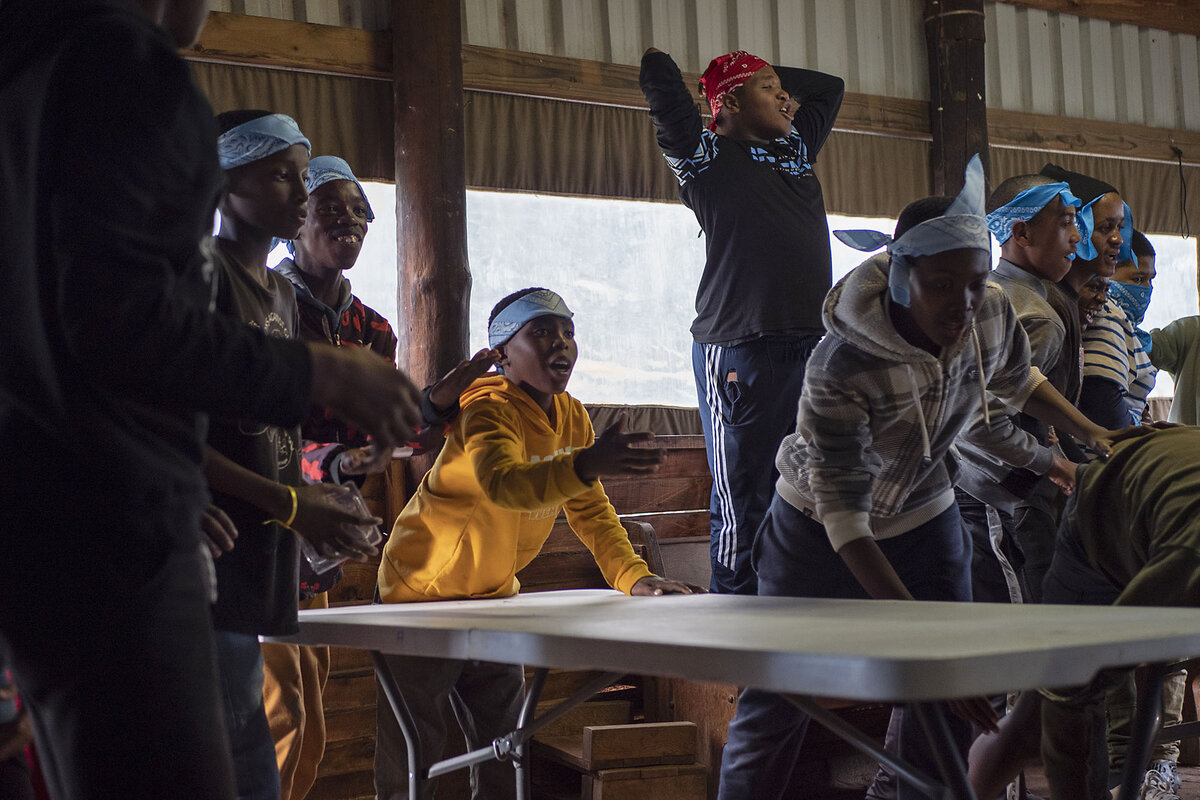
- Quick Read
- Deep Read ( 5 Min. )
-
By Julie Bourdin Contributor
At an overnight camp an hour outside Cape Town, 13-year-old Ziyaad draws a red cross on a sheet of paper. “It’s my mom’s grave,” he explains. On one side of the paper, the teen has written his deepest concern: “I do not have a mother or a father. I’m afraid I won’t make it in life without them.” In another corner, he has sketched his dream: “I would like to be a President because I want a better South Africa.”
On a recent weekend, Ziyaad and 38 other boys ages 13 to 15 gathered here with an unusual purpose. They were there as part of a mentoring program that aims to turn South African boys into “everyday activists” and defenders of women and girls.
With almost 11 women killed every day, South Africa has among the highest recorded rates of female homicide in the world.
The way boys are raised is one of the underlying causes of this gender-based violence epidemic, says Lerato Kossie, program coordinator at the Justice Desk, the human rights nonprofit that organizes this camp.
“A boy is told, ‘You must never cry; you must be the protector, the provider,’” he says. “We were taught to become robots and disconnect from our emotions.”
Now, the Justice Desk is trying to break the cycle.
In South Africa, curbing violence starts with showing boys their potential
A studious silence descends on the large tent that, minutes earlier, was filled with a whirlwind of activity as two dozen teenagers danced and bantered to loud South African amapiano beats. Now the boys are crouched over tables scattered with glitter and crayons, occasionally glancing up at the question scrawled on a whiteboard: “Who are you?”
Ziyaad, 13 years old, draws a red cross on a sheet of paper. “It’s my mom’s grave,” he explains to junior counselor Lutho Gcelu, who peers over his shoulder. On one side of the paper, the teen has written his deepest concern: “I do not have a mother or a father. I’m afraid I won’t make it in life without them.” In another corner, he has sketched his dream: “I would like to be a President because I want a better South Africa.”
On a recent weekend, Ziyaad was one of 39 boys ages 13 to 15 who gathered at this lush campsite an hour outside Cape Town with an unusual purpose. (Like other boys in this story, Ziyaad is using only his first name.) They were there as part of a mentoring program called iNtsika yeThemba – or Pillars of Hope – that aims to turn South African boys into “everyday activists” and defenders of women and girls.
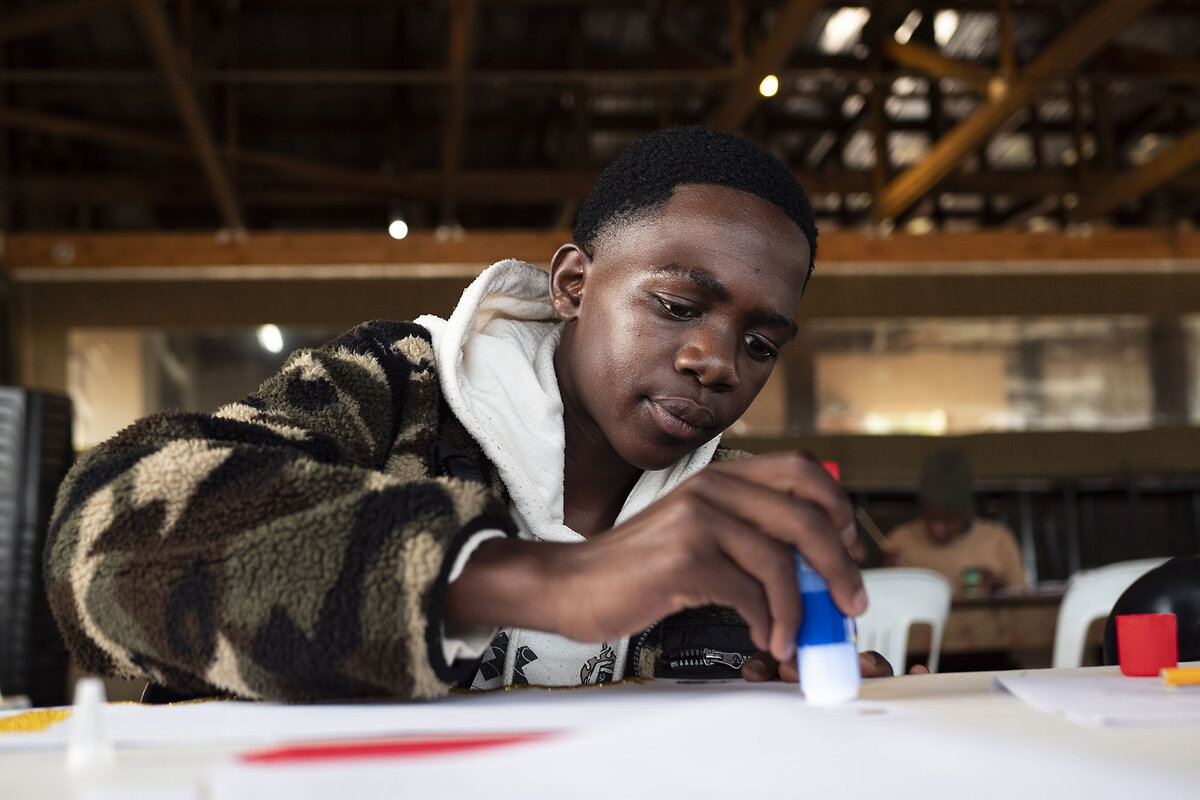
With almost 11 women killed every day, South Africa has among the highest recorded rates of female homicide in the world. Meanwhile, according to police statistics, over 12,000 rapes were recorded in the last 3 months of 2023 alone. Earlier this year, South African President Cyril Ramaphosa urged all men to sign a pledge committing to end violence against women and girls. But despite decades of campaigning, femicide is still on the rise.
The way boys are raised is one of the underlying causes of this gender-based violence epidemic, says Lerato Kossie, program coordinator at the Justice Desk, the human rights nonprofit that organizes iNtsika yeThemba.
“A boy is told, ‘You must never cry; you must be the protector, the provider,’” he says. “We were taught to become robots and disconnect from our emotions.”
But iNtsika yeThemba wants to break that cycle. The boys in the program go for counseling, take regular field trips, and attend yearly overnight camps like this one, where they compete in mock Olympics, play soccer, and have candid conversations about identity, masculinity, and the pressures of teenage life in some of the country’s most disadvantaged communities.
“Here, by removing them from the daily norms and duties at home, we see boys who can express themselves fully,” Mr. Kossie says.
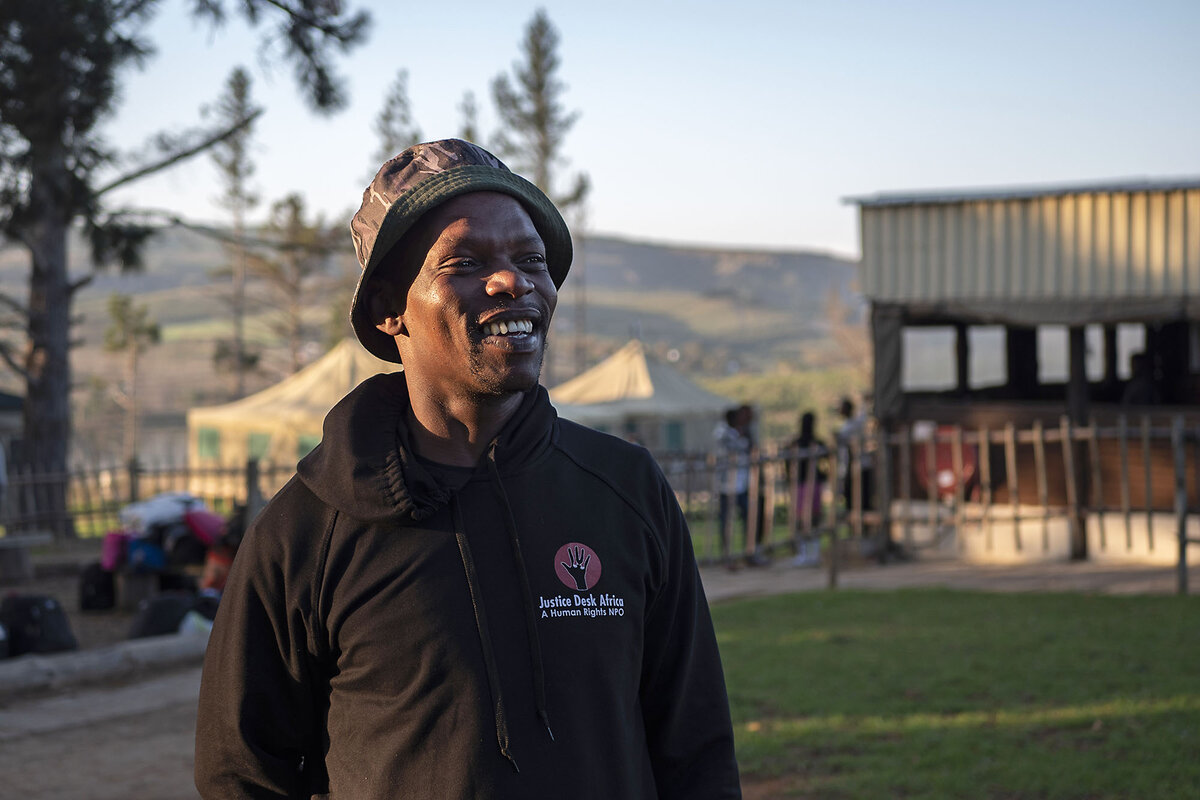
Thirty years after the end of apartheid, which segregated and oppressed South Africa’s nonwhite majority, “the country is still very much healing,” Mr. Kossie says. The aftershocks are most visible in townships, the mostly Black, working-class neighborhoods at the fringes of South African cities. Here, violence and unemployment still hit communities hard. “I see generations and generations going through the same cycle of drinking and drug use,” he says. “We need a new generation of positive male role models.”
Fixing the wheel
On the first evening of camp, the campers sit in a circle, bundled in warm pajamas. Shuffling on their chairs to stay awake, they lean in to hear Mr. Kossie’s voice over the roar of the wind outside. “Why is there crime in Nyanga?” he prods, asking about the Cape Town township that many of the boys come from.
The answers tumble out.
“No jobs!”
“No education!”
“Poverty!”
“Drugs!”
Mr. Kossie scribbles them on the whiteboard.
“And how does that come back to you? How are you stopping that cycle?” he asks. “Even me, today, I’m still trying to fix that wheel,” he continues, launching into his own story.
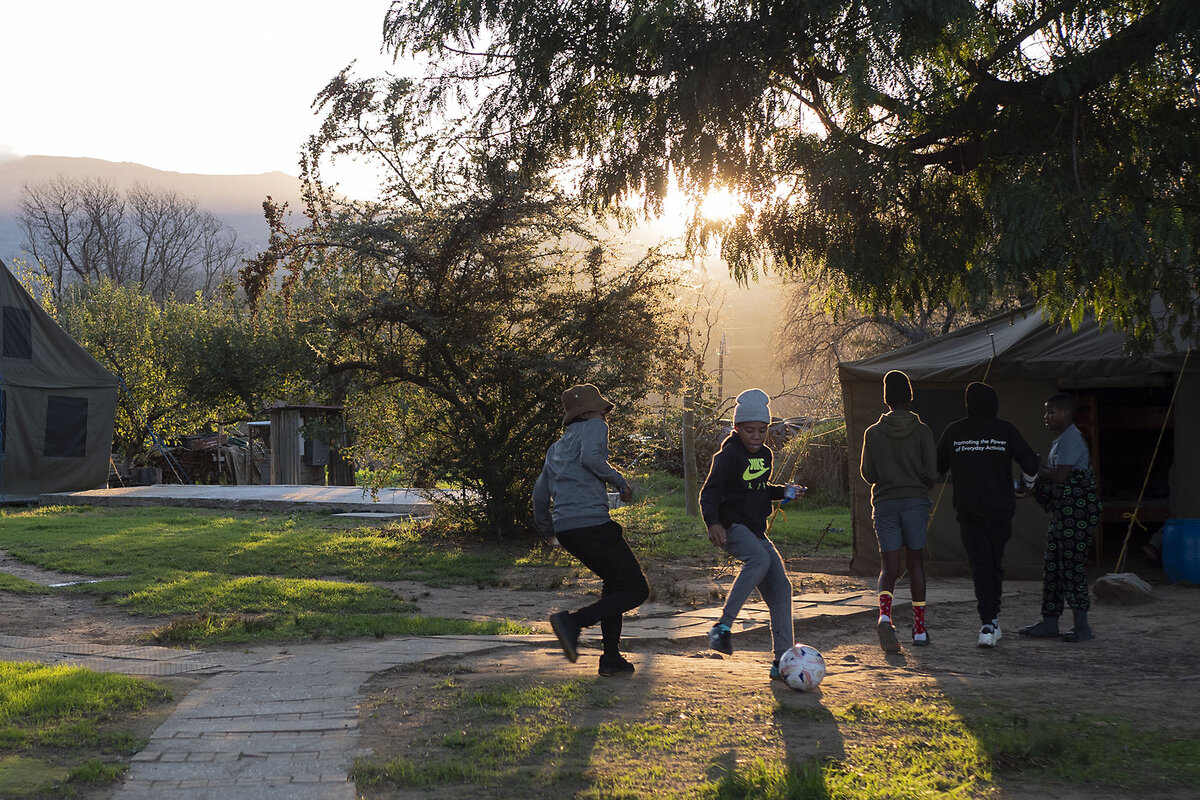
In 1997, at the age of 18, Mr. Kossie was arrested after getting involved with a gang. Incarcerated in Pollsmoor, Cape Town’s notorious maximum security prison, “I battled with the question ‘Who am I?’” he remembers. “I knew my identity as a gang member, but when I was removed from that society, the question came striking back. The answer I came to is that I’m a human being that is allowed to make mistakes.”
When the charges were dropped eight months later, Mr. Kossie pledged he would make sure other youths would never know “the smell of Pollsmoor.”
In a corner of the room, a 15 year-old – whose name has been omitted to protect his privacy – listens with glistening eyes as the program coordinator shares his story. The teen struggles at school and has battled suicidal thoughts. In his “Who are you?” drawing, he sketches small clouds carrying the words “not worthy” and “depression.”
But later, at an improvised talent show, he jumps onto the stage and, joined by his new friends, performs a rap song in isiXhosa to the flashing of torchlights. His favorite takeaway from the camp is something Mr. Kossie said. “[He] said you must have belonging in your life,” the boy says. “Belonging is a powerful thing.”
“What I stand for”
The morning after Mr. Kossie’s first session about breaking the cycle, the boys explore the roots of their anger. Counselors encourage them to describe what rage feels like.
“It’s like hot water boiling up inside,” explains Corbin, who is 13.
“Like your body is forcing you to do something,” another boy pitches in.
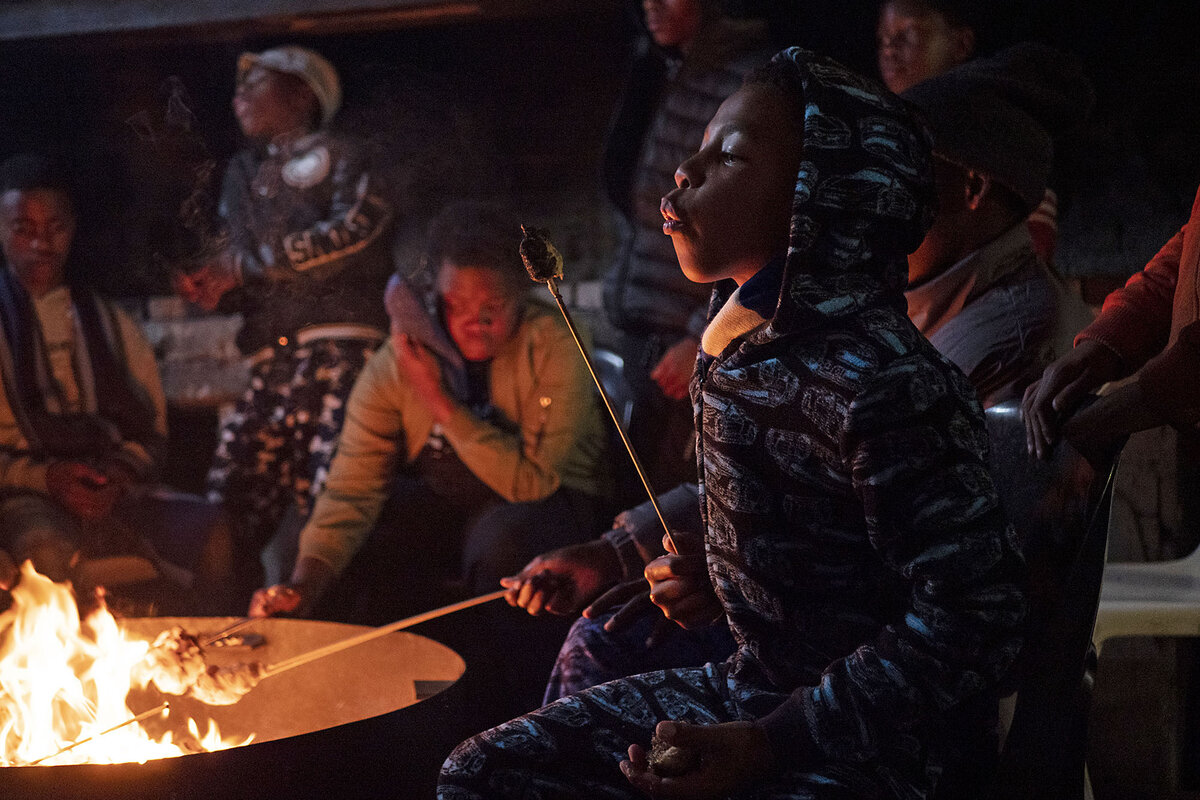
For Mr. Gcelu, the junior counselor, the discussion feels personal. “I had too much rage, growing up. I was like a grenade,” he remembers. After graduating from the program last year, he came back this year at the age of 19 as a “big brother.” “Sometimes I wish I could live at the Justice Desk all year,” he says, smiling.
Jamie, a lanky 15 year-old with a mischievous smile who is in his fifth year with iNtsika yeThemba, also takes pride in introducing the newer boys to the camp. “I feel like it’s my job to help them understand that this is a safe place,” he says.
If it wasn’t for the program, “I probably would be roaming the streets with my friends, doing bad stuff,” Jamie admits. “Now ... I know what to stand up for.”
Case in point: Last year, the teenager broke up an incident of domestic violence in the street. “At first, the woman didn’t want to lay charges, but I stood up for her because I knew she was scared of her boyfriend,” he remembers.
He convinced the woman to open a case, and says that the perpetrator is still in prison. “I feel like that won’t be my last time,” he says. “I will do it again.”
Other headline stories we’re watching
(Get live updates throughout the day.)The Monitor's View
Europe’s election: The art of listening
- Quick Read
- Deep Read ( 2 Min. )
-
By the Monitor's Editorial Board
In a year of big elections worldwide, one of the biggest – with 27 countries voting for a new European Parliament June 6-9 – has just delivered a message similar to those of other recent contests: Voters want leaders to try harder to define a political center.
While right-wing parties made gains in the Continent-wide vote – even forcing a parliamentary election in France in a few weeks – the real story is how much politicians of both the left and the right have been listening to disillusioned voters across Europe. In Germany, for example, a centrist party founded just six months ago by a former leftist leader won 6% of the vote for the 720-strong European Parliament.
The center-right party of European Commission President Ursula von der Leyen held its own as the Parliament’s major force – after moderating its policies. The election result, said the commission leader, “comes with great responsibility for the parties in the center.”
Being meek enough to listen to voters might pay off. Ms. von der Leyen is expected to be chosen for another five-year term, although much depends on the political parties that have repositioned their views and are willing to accommodate each other.
Europe’s election: The art of listening
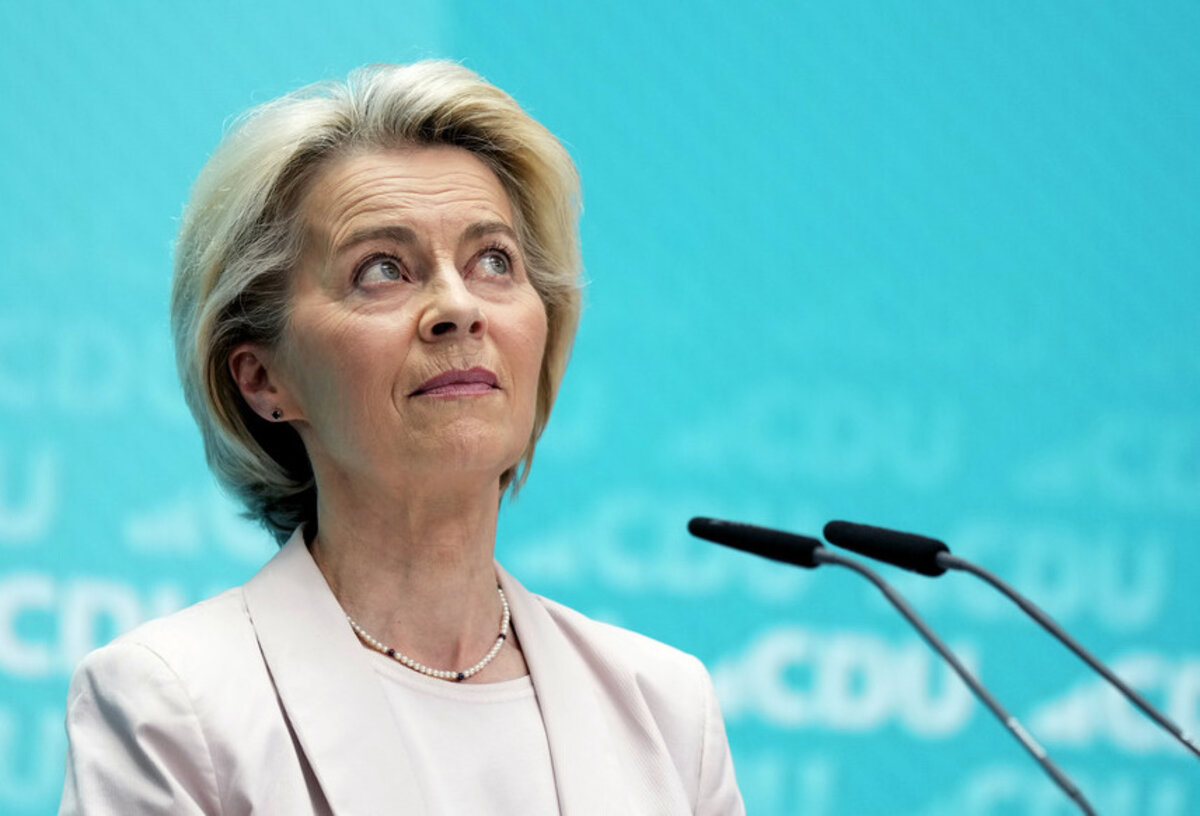
In a year of big elections worldwide, one of the biggest – with 27 countries voting for a new European Parliament June 6-9 – has just delivered a message similar to those of other recent contests: Voters want leaders to try harder to define a political center.
While right-wing parties made gains in the Continent-wide vote – even forcing a parliamentary election in France in a few weeks – the real story is how much politicians of both the left and the right have been listening to disillusioned voters across Europe, from angry farmers to young people fed up with established parties.
In Germany, for example, a centrist party founded just six months ago by a former leftist leader, Sahra Wagenknecht, won 6% of the vote for the 720-strong European Parliament. In Italy, the party of right-wing Prime Minister Giorgia Meloni did well but only after she moderated her views on migration, support for Ukraine, and the European Union. In France, the leader of the far-right National Rally, Marine Le Pen, has learned to accept the Eurocurrency.
Most of all, the center-right party of European Commission President Ursula von der Leyen held its own as the Parliament’s major force – after moderating its green policies and tightening migration flows. The election result, said the commission leader, “comes with great responsibility for the parties in the center.”
Being meek enough to listen to voters might pay off. Ms. von der Leyen is expected to be chosen for another five-year term, although much depends on the political parties in Parliament that have repositioned their views and are willing to accommodate each other.
Ms. von der Leyen once worked under longtime German chancellor Angela Merkel, who advised leaders to find a political space within which “different interests can be balanced and compromises reached.” Ms. Merkel also said the best leaders have an inner compass “that is based on overarching values.”
Europe’s identity relies less on victories for the left or right than on how well EU leaders listen to voters who feel left behind – the ones prone to back extremists. “The political earthquakes in Europe are more than just electoral shifts,” wrote pundit Diego Fassnacht in the Asia Times after the election. “As traditional power structures face challenges, new alliances and priorities are emerging.”
And EU leaders again learn that the art of consensus-based decision-making depends how well they listen.

A Christian Science Perspective
Each weekday, the Monitor includes one clearly labeled religious article offering spiritual insight on contemporary issues, including the news. The publication – in its various forms – is produced for anyone who cares about the progress of the human endeavor around the world and seeks news reported with compassion, intelligence, and an essentially constructive lens. For many, that caring has religious roots. For many, it does not. The Monitor has always embraced both audiences. The Monitor is owned by a church – The First Church of Christ, Scientist, in Boston – whose founder was concerned with both the state of the world and the quality of available news.
The heart of humility
- Quick Read
- Read or Listen ( 4 Min. )
-
By Larissa Snorek
When we’re willing to let go of a personal sense of ego and instead look to God for a spiritual perspective of our identity and abilities, healing and freedom naturally follow.
The heart of humility
Before they were Olympic champions, the rowers known as “the boys in the boat” had work to do to “subsume their individual egos for the sake of the boat as a whole.” This quote from the book “The Boys in the Boat: Nine Americans and Their Epic Quest for Gold at the 1936 Berlin Olympics” by Daniel James Brown (p. 241) gets at the heart of the humility that was required to enable these athletes to find greater success than they had initially thought possible. The author claims that “no other sport demands and rewards the complete abandonment of the self the way that rowing does” (p. 178).
Humility was key to the rowers working as a cohesive team. And while most of us don’t have our sights set on an Olympic victory, still, the practice of getting ego out of the way is integral to success in any worthwhile endeavor.
Often, though, it can feel as if just the opposite is true: that it is the assertion of self – of personal desires and abilities – that propels us to the top. Yet, ultimately, that personal sense of self and competence is grounded in limitation. Our abilities can seem to fluctuate. So relying on what we think we’re able to do ourselves, even if it’s exceptional, eventually leads to our coming up short.
Christ Jesus’ life presents a more effective model. He claimed no selfhood apart from God and no personal distinction, but said, “I am among you as one who serves” (Luke 22:27, New International Version). Yet his demonstration of healing power is unmatched in human history. Looking at his example, we can begin to understand that living with humility – setting aside a limited or material sense of self – actually illumines true, full individuality as the expression of God, Spirit.
We may think that emulating Jesus’ example is beyond us. But the master Christian came to demonstrate God’s allness and goodness for all people and for all time. And he showed what can be accomplished when we understand God as Love and our relation to this Love.
Jesus said, “By myself I can do nothing” (John 5:30, NIV). He humbly recognized his identity as sourced in God and God alone. This allowed Jesus to heal those afflicted with every sort of malady, including those that were life-threatening. He proved that success doesn’t rest on personal power, but on Christ, “the impersonal form of Truth” (Mary Baker Eddy, “Miscellaneous Writings 1883-1896,” p. 310).
And the same holds true for us. The humility that causes human will to give way to divine Truth isn’t a mental exercise but is about allowing Christ to clarify our sense of who we are and our oneness with God, so that we see from the standpoint of spiritual sense. Christly humility enables us to admit we are each the image of God. We start to see our being in terms of purity and health, goodness and joy. The way of Christ is one of meekness, as well as a confidence that doesn’t fluctuate but has the constancy of divine Love and Truth.
At a time when I was feeling heavily burdened by parenting and work responsibilities, I suddenly had severe pain that confined me to bed. During a day of prayer, I struggled to release the feeling that if I wasn’t the one to do everything on my plate, it just wouldn’t get done properly. But this sense of ego had to go. As Christlike thinking turned me toward quietly listening to God, I realized I could stop feeling like the mover and shaker of my life and accept what Love was doing. With this meekness came a release of the pain.
Setting aside human ego in favor of our spiritual identity and capacities lets us see the truth of what Mrs. Eddy, the founder of Christian Science, wrote in her seminal work, “Science and Health with Key to the Scriptures”: “Man is the expression of God’s being” (p. 470). Through humility we see our real self as God-expressed, wholly apart from a limited, mortal view. Peace and clarity, willingness and joy are not fault-ridden personal character traits; they come from the one infinite source and constitute who we are. And as we increasingly recognize and accept this true sense as the basis from which we live, we find healing and freedom.
This is the greatest victory we can ask for. Through humility we see our nature as God-sourced and God-maintained – and everyone else’s as well.
Adapted from an editorial published in the June 10, 2024, issue of the Christian Science Sentinel.

Viewfinder
Waiting for the vote
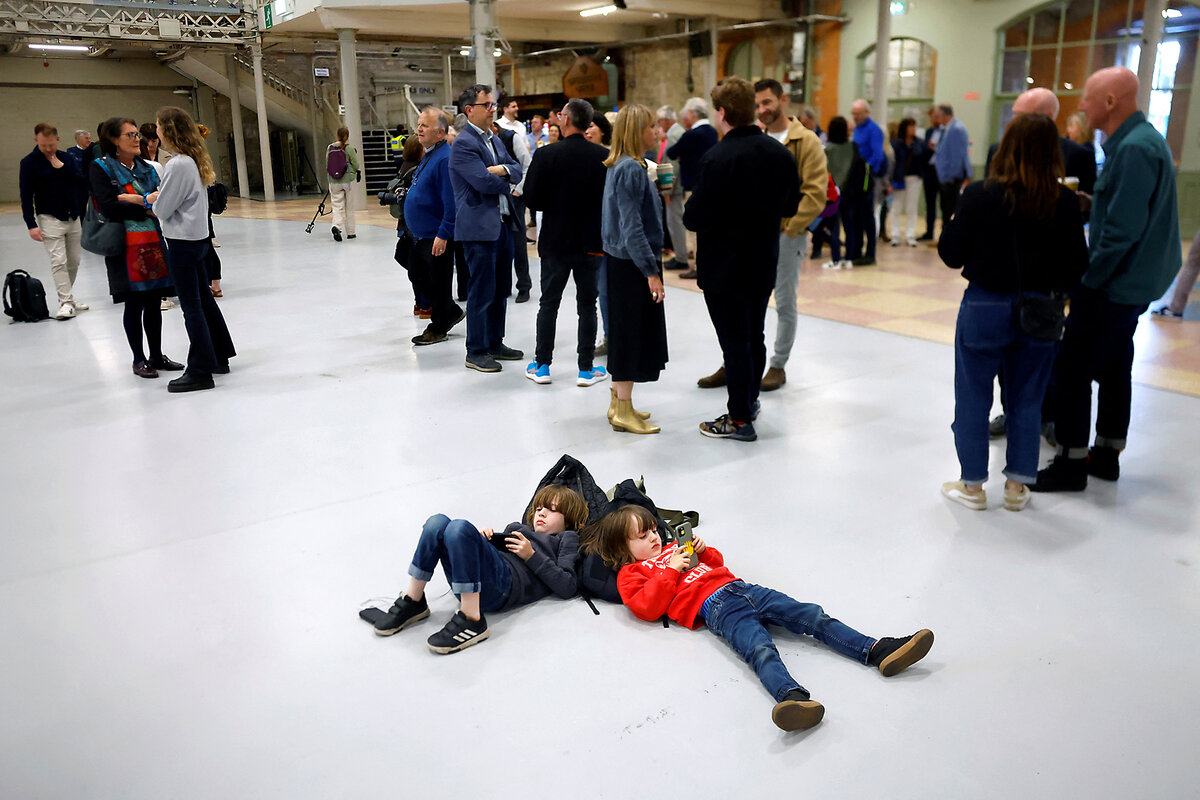
A look ahead
Thanks for starting a new week with us. Come back tomorrow. We’re working on stories that look at the far right’s gains in Europe’s elections, cricket’s growing fan base in the United States, and how Olympic basketball team rosters are made.



